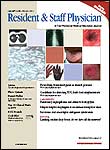Publication
Article
Resident & Staff Physician®
January 2008 Vol 54 No 1Volume0 Issue 0
Top 10 Clinical Pearls in Deep-Vein Thrombosis
Prepared by Tarek Darwish, MD, Assistant Professor of Medicine, Department of InternalMedicine, Division of Hospital Medicine, University of Missouri-Kansas City
- Assess patients on admission and on a daily basis for possible change of deep-vein thrombosis (DVT) status, including the total risk factor score (a score of 2 or above is an indication for prophylaxis). In some cases, pharmacologic prophylaxis may need to be continued posthospitalization.
- Don?t forget to ask about a history of DVT or pulmonary embolism, and make DVT prophylaxis an essential part of your assessment and management plan.
- Mechanical prophylaxis, such as a sequential compression device or graduated compression stockings, should be considered in patients with contraindications to anticoagulation (eg, active hemorrhage, recent intraocular or intracranial surgery, heparin-induced thrombocytopenia [HIT], spinal tap or epidural anesthesia within 24 hours).
- Unfractionated heparin and low-molecularweight heparin (LMWH) are the most common pharmacologic agents used in hospitalized patients. No single agent has been proved superior to another in efficacy; however, unfractionated heparin, given 3 times daily, is associated with a greater incidence of HIT and requires more nursing time.
- Remember to use unfractionated heparin 3 times daily instead of twice daily in medical and surgical patients because of the lack of convincing evidence showing efficacy of twice-daily unfractionated heparin.
- The combination of pharmacologic and mechanical prophylaxis is recommended in very-high-risk patients, despite the absence of randomized controlled trials.
- Remember to withhold unfractionated heparin 4 to 6 hours and LMWH 24 hours before placement or removal of an epidural or spinal catheter.
- LMWH may be preferred to unfractionated heparin in patients with malignancy based on the recent findings of antineoplastic and antiangiogenic effects of LMWH.
- Consider checking the patient?s complete blood count, with differential, periodically in those receiving unfractionated heparin or LMWH therapy; recognize HIT early as the most common serious drug reaction in the hospital setting.
- Use LMWH with caution in patients with renal failure (eg, serum creatinine clearance under 30 mL/min).
Related Content
